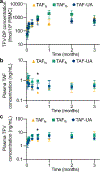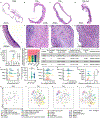Changes in local tissue microenvironment in response to subcutaneous long-acting delivery of tenofovir alafenamide in rats and non-human primates
- PMID: 37120032
- PMCID: PMC10330370
- DOI: 10.1016/j.jconrel.2023.04.037
Changes in local tissue microenvironment in response to subcutaneous long-acting delivery of tenofovir alafenamide in rats and non-human primates
Abstract
Several implantable long-acting (LA) delivery systems have been developed for sustained subcutaneous administration of tenofovir alafenamide (TAF), a potent and effective nucleotide reverse transcriptase inhibitor used for HIV pre-exposure prophylaxis (PrEP). LA platforms aim to address the lack of adherence to oral regimens, which has impaired PrEP efficacy. Despite extensive investigations in this field, tissue response to sustained subcutaneous TAF delivery remains to be elucidated as contrasting preclinical results have been reported in the literature. To this end, here we studied the local foreign body response (FBR) to sustained subdermal delivery of three forms of TAF, namely TAF free base (TAFfb), TAF fumarate salt (TAFfs), and TAFfb with urocanic acid (TAF-UA). Sustained constant drug release was achieved via titanium-silicon carbide nanofluidic implants previously shown to be bioinert. The analysis was conducted in both Sprague-Dawley (SD) rats and rhesus macaques over 1.5 and 3 months, respectively. While visual observation did not reveal abnormal adverse tissue reaction at the implantation site, histopathology and Imaging Mass Cytometry (IMC) analyses exposed a local chronic inflammatory response to TAF. In rats, UA mitigated foreign body response to TAF in a concentration-dependent manner. This was not observed in macaques where TAFfb was better tolerated than TAFfs and TAF-UA. Notably, the level of FBR was tightly correlated with local TAF tissue concentration. Further, regardless of the degree of FBR, the fibrotic capsule (FC) surrounding the implants did not interfere with drug diffusion and systemic delivery, as evidenced by TAF PK results and fluorescence recovery after photobleaching (FRAP).
Keywords: Foreign body response; Immune microenvironment; Long acting drug delivery; Subcutaneous implants; Tenofovir alafenamide.
Copyright © 2023 The Authors. Published by Elsevier B.V. All rights reserved.
Figures





References
-
- UNAIDS. ‘Miles to go: global AIDS update 2018’, p.59. [pdf]. (2018).
-
- Ray AS, Fordyce MW & Hitchcock MJ Tenofovir alafenamide: a novel prodrug of tenofovir for the treatment of human immunodeficiency virus. Antiviral research 125, 63–70 (2016). - PubMed
Publication types
MeSH terms
Substances
Grants and funding
LinkOut - more resources
Full Text Sources
Medical
Miscellaneous

